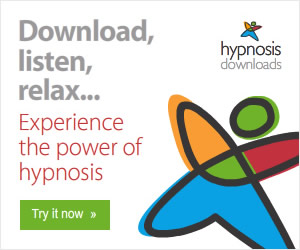Many people have completely the wrong idea about hypnosis, fearing that they will lose control, be made to do or say things against their will or worry that they might stay in hypnotic trance. I want to alleviate your fears and describe a typical clinical hypnosis session.
First of all, if you have ever seen a stage hypnosis show, you might have seen people do or say silly and embarrassing things. Remember that people volunteer to go on stage so know they will be asked to make exhibitionists of themselves. Some shows are X-rated but most shows are good, clean family fun. I used to hold a negative view of stage hypnosis but now offer a fun show, either as a complete show or as a demonstration for clubs and companies as an introduction to clinical hypnosis.
During stage hypnosis, the hypnotist will give individuals messages to tell them to do or say funny things but all suggestions will be removed before the end of the show and people return to normal, usually wanting to buy a DVD of the show to see how they performed. Clients go to a clinical hypnotist for help with a particular problem eg to stop smoking, lose weight, overcome a fear or phobia, increase self-confidence, improve a sport, alleviate pain, a health condition or deal with an addiction. Some specialise in specific conditions but most help with a wide variety of issues.
A professional hypnotist will carry out a detailed consultation asking questions about your lifestyle and the background to the issue. They will then describe the experience of hypnosis so that you understand that it is a perfectly natural, everyday state which we all know. If you are engrossed in a film on TV and someone calls you, you might not hear them. If they call again, louder, they will bring your attention back in the room. When you are engrossed, you are in a state of trance ie altered awareness. You cannot be in this state unless you are relaxed mentally and physically. You see, it is a state you already know and frequently experience.
There may be a test of suggestibility eg the hands clasp or rising and falling arms. A quick result will mean that you make a good subject for hypnosis. Lack of result or a slow result does not mean that you cannot be hypnotized but simply that you might take longer and require a lengthier induction process.
An induction is the talking to lead you into a hypnotic state. Very rarely a hypnotist will use a pendulum like a swinging crystal or ask you to stare at a flickering candle. This simply tires the eye muscles so that you want to close your eyes and start relaxing. If this is the first time you have been hypnotized, or if you are stressed and tense, you may need an induction lasting several minutes. However, there is no fast rule. If you are highly motivated to achieve a result, you may enter quickly into trance. There are fast induction methods which can put a subject into a deep state in a matter of seconds! The main objective here is to have you close your eyes and focus on your breathing. Once your body is relaxed, you will be asked to visualize a scene which serves to distract and relax your mind. This might be a beach, a lake, a meadow or garden.
Next a deepener to deepen the relaxed state which usually asks you to visualize walking slowly downstairs or going down in a lift. The emphasis is on going “down, deeper”.
Remember that no one can put you into hypnosis against your will as all hypnosis is self-hypnosis and you will only go into this state when it is safe for you to do so, never when operating machinery or driving a car.
For treating many of the reasons why people come to a clinical hypnotist, some ego strengthening or confidence-boosting is necessary. Sometimes we have been told “we can’t” for so long that we need to believe “we can”. We focus on being calm, relaxed and confident. Specific techniques will then follow to help overcome your issue, your habit, health problem, phobia, addiction or just to strengthen your confidence. There are many techniques involved in clinical hypnosis and your success will depend on the training, skill and experience of the practitioner. Having said that, even someone who is newly qualified can achieve good results.
I shall also mention two specific areas: regression and parts therapy. Regression uses visualization to take you back to an earlier time to identify the cause of a problem or to re-write a negative association. Parts integration deals with incongruencies when you say, “Part of me.... but part of me....”
You may also be taught self-hypnosis which is a very useful skill to use throughout your life in many situations. You may be given specific post-hypnotic suggestions or triggers to reinforce a new positive behaviour.
Simple issues can be dealt with in a single session but most require 2-5 sessions. Your hypnotist will discuss this at the first session. Weight loss may require many sessions over a period of time. It is most important that you be realistic and commit to the full course if you want a long-lasting successful outcome. Think of learning to drive, a new language, a skill and expecting success by just attending the first couple of lessons. You will have a little knowledge but not enough to be competent. So it is with hypnosis. Don’t expect a magic wand. This is the most powerful tool on the planet for fast, life-changing results but only if you commit to the recommended course.
Finally, time distorts in hypnosis so you might be surprised to find that what feels like a few minutes was actually much longer. The other benefit of hypnosis is that 30 minutes can refresh you as much as a night of good sleep. So, positive, life-enhancing results, a calm relaxed feeling and extra vitality. Sounds wonderful.
© Antonia Harrison 2011. Antonia Harrison is the English Clinical Hypnotist in Belgium specializing in stopping smoking, controlling alcohol consumption, overcoming the fear of public speaking and phobias. She is a competent public speaker and rid herself of a life-long spider phobia. She also gave birth twice without conventional pain control using self-hypnosis for low pain childbirth without tearing or bruising. http://www.HypnotherapyBelgium.com












No comments:
Post a Comment